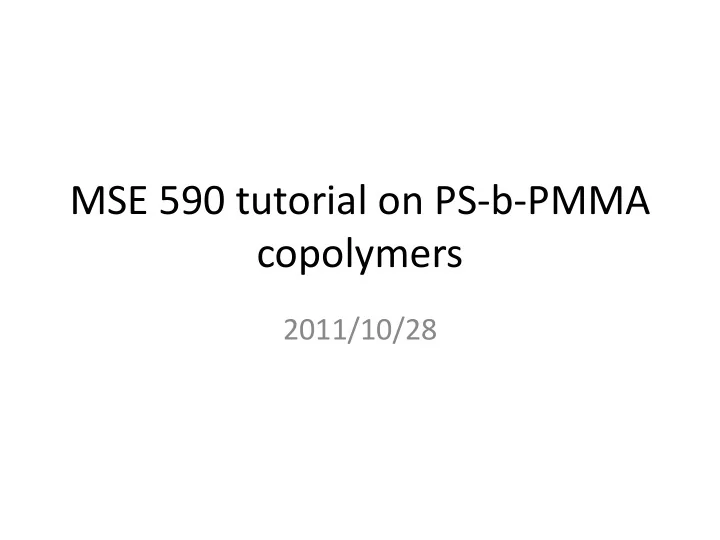

MSE 590 tutorial on PS-b-PMMA copolymers 2011/10/28
Chemical structure and physical properties of PS (Polystyrene) Chemical structure: An aromatic polymer made from the monomer styrene (C 8 H 8 ) n Physical properties: Glass transition temperature: around 95 °C Dielectric constant: 2.4–2.7 Density: 1.05 g/cm3 Thermal conductivity: 0.08 W/(m·K) Application: Sheet or molded polystyrene, polystyrene foam, copolymers…
PS loss spectrum Relatively small values, Dielectrically inactive -1 10 0 0 C to 80 0 C -2 10 ε′′ ( ω ) -3 10 PS -4 10 -2 0 2 4 6 10 10 10 10 10 Frequency (Hz)
Chemical structure and physical properties of PMMA (Poly(methyl methacrylate) Chemical structure: Chemically, it’s synthetic polymer of monomer methyl methacrylate (C 5 O 2 H 8 ) n Polymerization Physical properties: Glass transition temperature: around 105 °C (atactic) Refractive index: 1.4914 at 587.6 nm Density: 1.18 g/cm 3 Melting point: around 160 °C Application: Transparent glass substitute (fish tank), Medical technologies and implants, Artistic and aesthetic uses…
PMMA Loss Spectrum 3 10 2 PMMA 10 60 0 C to 150 0 C 1 10 ε′′ ( ω ) 0 10 -1 10 -2 10 -2 0 2 4 6 10 10 10 10 10 Frequency (Hz)
PS-b-PMMA and PS/PMMA samples Sample preparation PS-b-PMMA : 1. Heated to 180 °C for 10 minutes and pressed under 1000 lb load. 2. Decreased to room temperature by keeping 300 lb load. Blends of PS /PMMA: 1. Heated to 180 °C for 30 minutes and pressed under 600 lb load test for 5 minutes. 2. Decreased to room temperature by keeping 600 lb pressure. After the hot pressing processes, samples were all polished and sputtered by Ag electrodes.
PS-b-PMMA and PS/PMMA samples Dielectric measurement using Broad Band NOVOCONTROL spectroscopy with automatic temperature control from -40 °C to 150 °C and frequency range from 0.01 Hz to 1 MHz. Table 1. Molecular weight, diameter and thickness of the samples. Samples M w Diameter (mm) Thickness (mm) Volume fraction f PS PMMA 50 K 19.88±0.01 1.25±0.01 PS 50 K 19.865±0.005 0.94±0.01 PS-b-PMMA 50K-50K 19.88±0.01 0.855±0.005 0.53±0.03 (Sample 1) PS-b-PMMA 50K-50K 19.82±0.01 0.575±0.005 0.53±0.03 (Sample 2) PS-b-PMMA 50K-130K 19.82±0.01 0.575±0.005 0.53±0.03 PS/PMMA 50K/50K 19.90±0.01 0.905±0.005 0.53±0.03
2D imaginary permittivity plots of copolymer PS-b-PMMA 2 1.5 1 0.5 DC Conductivity log 10 ε′′ 0 60 o C to 150 o C β Relaxation Process -0.5 -1 -1.5 α Relaxation Process -2 -2 -1 0 1 2 3 4 5 6 log 10 ( ω /Hz)
Review on the Basic models
Presentation of different Models on Complex Plane of Dielectric Constant Davidson-Cole Debye Cole-Cole Havriliak-Negami Havriliak-Negami model Water Polymers Is most suitable for PS-b-PMMA
Experimental Data Cole-Cole Material of Sample: PMMA Davidson-Cole Havriliak-Negami Complex plane of dielectric constant at T=40 o C 0.4 ε′′ ( ω ) Comparison 0.2 1. Cole-Cole describes the 0 circular arc behavior at 2.8 3 3.2 3.4 3.6 3.8 4 4.2 4.4 4.6 4.8 low frequencies. ε′ ( ω ) 2. Davidson-Cole Complex plane of dielectric constant at T=60 o C describes the skew line 0.4 behavior at high ε′′ ( ω ) frequencies. 0.2 3. Havriliak-Negami combines the 0 2.8 3 3.2 3.4 3.6 3.8 4 4.2 4.4 4.6 4.8 advantages of the ε′ ( ω ) Complex plane of dielectric constant at T=80 o C above two models. Appearance of 0.4 ε′′ ( ω ) new relaxation 0.2 process as T approaches T g 0 2.8 3 3.2 3.4 3.6 3.8 4 4.2 4.4 4.6 4.8 ′ ( )
Physical Mechanisms frequency of occurrence increases Conductivity term: The contribution of free charge carriers α -relaxation process: Attributed to long chain segmental motion within the main polymer chain β -relaxation process: Primary localized motion of side segments
Fitting Strategy: Least-Squares Fitting of HN parameters
Modeling Example T < T g 0.16 experimental data 0.14 relaxation conductivity term 0.12 model superposition 0.1 ε′′ ( ω ) 0.08 0.06 90 o C 0.04 0.02 0 -2 0 2 4 6 10 10 10 10 10 Frequency (Hz)
Modeling Example T > T g 0 10 PS-b-PMMA 50K-130K T=105 0 C -1 10 PS-b-PMMA 50K-50K T=105 0 C -2 10 ε′′ ( ω ) -3 10 -4 10 Experimental data α relaxation β relaxation -5 10 conductivity model superposition -6 10 -2 0 2 4 6 10 10 10 10 10 Frequency (Hz)
Relaxation Map (a) 5 PMMA PS/PMMA blends 4 PSbPMMA 50-50K PSbPMMA 50-130K 3 5.5 (b) 2 PMMA PS/PMMA blends 1 f max (Hz) PSbPMMA 50-50K 5 PSbPMMA 50-130K 0 -1 4.5 f max (Hz) -2 4 -3 -4 3.5 -5 2.4 2.6 2.8 3 3.2 3.4 3.6 Temperature 1000/T (K -1 ) 3 2.4 2.45 2.5 2.55 2.6 2.65 2.7 2.75 Temperature 1000/T (K -1 )
Temperature-dependence Behavior
αβ -type relaxation For the region around glass transition temperature, the temperature dependence behavior can not be fitted well by both of Arrhenius Eqn. and Vogel-Fulcher Eqn., it is αβ -type complicated relaxation.
Fitting parameters of α relaxation α relaxation f max D T 0 (K) T g (K) PMMA 3.97e8 2.50 337 95.4 PS/PMMA blends 1.68e7 1.80 342 96 PSbPMMA 50-50k 4.21e2 0.56 354 96.8 PSbPMMA 50-130k 2.65e2 0.44 358 97.6
Fitting parameters of β relaxation β relaxation E A (KJ, T >T g ) E A (KJ, T<T g ) PMMA 105.5 78.2 PS/PMMA blends 106.1 77.9 PS-b-PMMA 50-50K 88.6 75.4 PS-b-PMMA 50-130K 88.0 82.0
Conductivity effects -4 PMMA 135 0 C PMMA 140 0 C -5 PMMA 150 0 C -6 PSbPMMA 50-50K 132 0 C PSbPMMA 50-50K 140 0 C -7 PSbPMMA 50-50K 150 0 C log10[ σ (S/m)] PSbPMMA 50-130K 132 0 C -8 PSbPMMA 50-130K 140 0 C PSbPMMA 50-130K 150 0 C -9 -10 -11 -12 -2 -1 0 1 2 3 4 5 6 log10[Frequency (Hz)]
Conductivity effects (Cont’d)
Conductivity effects (Cont’d) DC conductivity σ 0 (S/m) A T 0 (K) PMMA 5.39e-4 1985 283 PSbPMMA 50-50k 5.15e-6 1075 330 PSbPMMA 50-130k 1.99e-1 3584 257
Recommend
More recommend